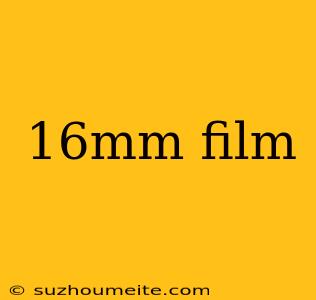16mm Film: A Brief History and Its Significance in Cinematography
Introduction
The 16mm film format has been a staple in cinematography for decades, offering a unique aesthetic and versatility that has made it a favorite among filmmakers, documentarians, and artists. In this article, we'll delve into the history of 16mm film, its characteristics, and its significance in the world of cinematography.
The Birth of 16mm Film
In the early 1920s, the 16mm film format was introduced by Eastman Kodak as a more affordable and portable alternative to the larger 35mm format. The initial intention was to create a film format for amateur home movie makers, but it soon gained popularity among professionals as well. The smaller size and lighter weight of 16mm film made it ideal for documentary filmmaking, newsreels, and educational films.
Characteristics of 16mm Film
16mm film has several distinct characteristics that set it apart from other film formats:
- Smaller gauge: 16mm film is significantly smaller than 35mm film, making it more portable and easier to handle.
- Lighter weight: The smaller size and lighter weight of 16mm film make it ideal for handheld cameras and location shooting.
- Lower cost: 16mm film is generally less expensive than 35mm film, making it more accessible to independent filmmakers and students.
- Unique aesthetic: 16mm film has a distinct grainy quality that adds a nostalgic and textured look to footage.
The Golden Age of 16mm Film
The 1960s and 1970s are often referred to as the golden age of 16mm film. During this period, the format became popular among independent filmmakers, documentarians, and experimental artists. The portability and affordability of 16mm film made it an ideal choice for capturing realistic and intimate footage.
Notable Filmmakers and Their Work
- John Cassavetes: Known for his improvisational style, Cassavetes used 16mm film to create intimate and realistic dramas such as "Shadows" (1959) and "Faces" (1968).
- Stan Brakhage: An experimental filmmaker, Brakhage used 16mm film to create avant-garde works that explored the nature of perception and the human experience.
- Chris Marker: A French filmmaker, Marker used 16mm film to create influential documentaries such as "Letter from Siberia" (1957) and "Far from Vietnam" (1967).
The Decline and Resurgence of 16mm Film
With the advent of digital technology, 16mm film began to decline in popularity in the 1980s and 1990s. However, in recent years, there has been a resurgence of interest in 16mm film among filmmakers, artists, and enthusiasts.
Why Filmmakers Still Love 16mm Film
- Unique aesthetic: 16mm film provides a distinct look that is impossible to replicate with digital technology.
- Tactile experience: Shooting with 16mm film offers a tactile experience that is often missing from digital filmmaking.
- Artistic expression: 16mm film provides a unique canvas for artists to express themselves and push the boundaries of cinematic storytelling.
Conclusion
16mm film has played a significant role in the history of cinematography, offering a unique aesthetic and versatility that has made it a favorite among filmmakers, documentarians, and artists. While digital technology has become the norm, 16mm film continues to inspire and influence filmmakers, ensuring its relevance and importance in the world of cinematography.
